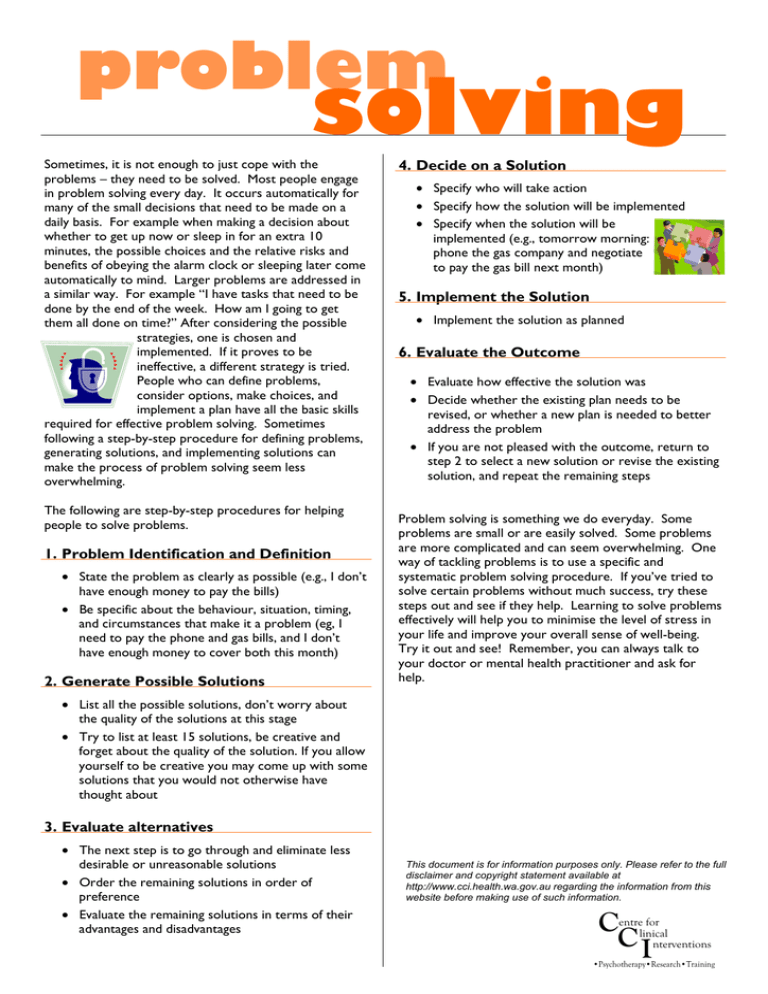Problem-Solving Techniques: A Step-by-Step Guide
advertisement

problem solving Sometimes, it is not enough to just cope with the problems – they need to be solved. Most people engage in problem solving every day. It occurs automatically for many of the small decisions that need to be made on a daily basis. For example when making a decision about whether to get up now or sleep in for an extra 10 minutes, the possible choices and the relative risks and benefits of obeying the alarm clock or sleeping later come automatically to mind. Larger problems are addressed in a similar way. For example “I have tasks that need to be done by the end of the week. How am I going to get them all done on time?” After considering the possible strategies, one is chosen and implemented. If it proves to be ineffective, a different strategy is tried. People who can define problems, consider options, make choices, and implement a plan have all the basic skills required for effective problem solving. Sometimes following a step-by-step procedure for defining problems, generating solutions, and implementing solutions can make the process of problem solving seem less overwhelming. The following are step-by-step procedures for helping people to solve problems. 1. Problem Identification and Definition • State the problem as clearly as possible (e.g., I don’t have enough money to pay the bills) • Be specific about the behaviour, situation, timing, and circumstances that make it a problem (eg, I need to pay the phone and gas bills, and I don’t have enough money to cover both this month) 2. Generate Possible Solutions 4. Decide on a Solution • Specify who will take action • Specify how the solution will be implemented • Specify when the solution will be implemented (e.g., tomorrow morning: phone the gas company and negotiate to pay the gas bill next month) 5. Implement the Solution • Implement the solution as planned 6. Evaluate the Outcome • Evaluate how effective the solution was • Decide whether the existing plan needs to be revised, or whether a new plan is needed to better address the problem • If you are not pleased with the outcome, return to step 2 to select a new solution or revise the existing solution, and repeat the remaining steps Problem solving is something we do everyday. Some problems are small or are easily solved. Some problems are more complicated and can seem overwhelming. One way of tackling problems is to use a specific and systematic problem solving procedure. If you’ve tried to solve certain problems without much success, try these steps out and see if they help. Learning to solve problems effectively will help you to minimise the level of stress in your life and improve your overall sense of well-being. Try it out and see! Remember, you can always talk to your doctor or mental health practitioner and ask for help. • List all the possible solutions, don’t worry about the quality of the solutions at this stage • Try to list at least 15 solutions, be creative and forget about the quality of the solution. If you allow yourself to be creative you may come up with some solutions that you would not otherwise have thought about 3. Evaluate alternatives • The next step is to go through and eliminate less desirable or unreasonable solutions • Order the remaining solutions in order of preference • Evaluate the remaining solutions in terms of their advantages and disadvantages This document is for information purposes only. Please refer to the full disclaimer and copyright statement available at http://www.cci.health.wa.gov.au regarding the information from this website before making use of such information. C CI entre for linical nterventions •Psychotherapy•Research•Training
